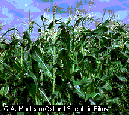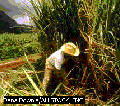Four
plants
 Corn Corn
Corn is native to the Americans. It grew wild from
eastern North America almost to the tip of South
America. Indians started planting it in gardens at
least 5,000 years ago. They even raised popcorn.
Some Indians ground their corn into flour and made
corn bread. Others made very flat corn pancakes.
Columbus took corn to Europe, and from there
it spread to other continents.
Today corn is a popular and important food
in the Americas. However, farmers use most of it
to feed cattle, pigs, and chickens. Soft drinks
are sweetened with corn sugar. People use corn oil
for cooking. Corn is also used to make paper and
industrial alcohol.
 Coffee Coffee
Coffee is the favorite hot drink in almost all
countries. A “coffee break” is an important
part of life in the United States.
An old story says that coffee was first
discovered in Ethiopia. Men taking care of their
sheep noticed that the sheep stayed awake all
night when they ate coffee beans and leaves.
Coffee was first used as a food, then a kind
of wine and then medicine. It became a drink about
700 years ago.
People took coffee to Arabia in the
thirteenth century. From there it went to Turkey,
Europe and the Americas.
In 1963 the United Nations helped organize
an International Coffee Agreement. Countries that
export coffee agree on the price. This agreement
helps Brazil and the other exporting countries get
a fair price.
 Sugar Sugar
Sugar cane is a kind of grass. It is a relative of
corn and bamboo. No one has ever found a wild
sugar plant, so no one is sure where the plant
came from. Scientists think it probably came from
Southeast Asia. Farmers were raising sugar cane in
India by 300 B.C. It reached China before the
first century B.C. and also moved slowly west to
Persia. When the Arabs won a war against Persia,
they introduced sugar throughout the Middle East,
Sicily, and Spain. Columbus took it to the New
World.
 Peanuts Peanuts
Peanuts are also called groundnuts because they
grow underground. A peanut is not really a nut. It
is a relative of beans and peas.
The peanut is a native of tropical South
America. Wild peanut plants still grow there.
Farmers raised peanuts at least 2,000 years before
Columbus went to the America.
The Portuguese took peanuts to Europe and
Africa, and the African slaves took them to North
America.
Today peanuts are raised in warm areas all
over the world. In West Africa, the peanut is an
important food. In most countries peanuts are used
for oil. However, in the United States they are
used for candy and peanut butter and to feed
animals.
Why
diets differ around the world
The kinds of food that people eat vary from one
country to another and even within countries. In
some countries, for example, the people eat much
meat. In some other countries, meat is served only
on special occasions. People who are vegetarians
eat no meat at all. Many people like certain foods
that other people find very unappetizing. For
example, the Chinese use the nests of birds called
swifts to make bird-nest soup. The birds build the
nests of their saliva. The people of Spain enjoy
fried baby eels. People in many countries consider
frog legs to be a treat.
People of various cultures also prepare
foods differently. In many cases, the fuel
resources and cooking equipment available
determine how foods are prepared. Thus, some
people cook foods over an open fire. Others may
use a microwave oven. Still others may eat most of
their foods raw. Some people add fiery spice to
their dishes. Others prefer little seasoning. Some
people eat only natural, or unprocessed foods.
Others eat foods that have been highly processed.
 Diets
differ for a number of reasons, including
geographic reasons, economic reasons, religious
reasons, and customs. But differences in diet are
not as great as they once were. The growth of
tourism and the development of modern
transportation and communication systems have led
to an exchange of foods and eating habits among
people throughout the world. Diets
differ for a number of reasons, including
geographic reasons, economic reasons, religious
reasons, and customs. But differences in diet are
not as great as they once were. The growth of
tourism and the development of modern
transportation and communication systems have led
to an exchange of foods and eating habits among
people throughout the world.
Diet
Customs
Customs influence what people eat and how they
prepare, serve, and eat foods. Many countries and
regions have traditional dishes, most of which are
based on locally produced foods. In many cases,
the dishes of various cultures include the same
basic ingredients. But different seasonings and
cooking methods give the dish a special regional
or national flavor. In the United States, for
example, people enjoy such distinctively different
chicken dishes as Southern-fried chicken,
Louisiana chicken Creole, and Texas-style
barbecued chicken.
Many people consider France to be the world
center of fine foods and cookery. French chefs are
especially known for their elaborate dishes with
rich sauces and for their fancy pastries. Perhaps
the most famous English dish is roast beef and
Yorkshire pudding, a batter pudding baked in beef
juice. Italy is known for its spaghetti, macaroni,
and other pastas and for its sauces made with
tomatoes, garlic, and olive oil. Sausages,
potatoes, cabbages, and beer are common in the
German diet. Scandinavians enjoy herring and other
fish. They also are noted for their excellent
cheeses and many kinds of bread, which range from
thin, crisp sheets to dark, heavy loaves.
The Spanish and Portuguese also eat much
fish. Their use of onions and garlic for seasoning
influenced cookery in the Caribbean islands,
Mexico, and other parts of Latin America that they
colonized. Caribbean cooking features such local
fruits and vegetables as plantains (a kind of
banana) and cassava (a starchy root). Mexican food
is noted for its use of a variety of peppers.
Mexicans enjoy flat corn-meal bread called
tortillas. They may eat the tortillas plain or
wrapped around bits of cheese, meat, and beans to
form tacos.
The main food of many people in the Middle
East is pita bread, a flat bread made from wheat.
For celebrations, people of the region often
prepare shish kebab. This dish consists of cubes
of lamb, tomatoes, peppers, and onions coasted on
a spike like skewer. Rice is the main dish of many
people in Japan, southern China, India, and
Southeast Asia. Japanese meals commonly include
vegetables, tofu (soybean curd), and raw or cooked
fish. Chinese cookery, which many people consider
among the finest in the world, varies greatly by
geographical region. Cooks in southern China
stir-fry chopped vegetables and meat, which they
serve with a mild sauce and rice. In northern
regions, people enjoy spicy fried foods served
with noodles. Indians and many Southeast Asians
enjoy curry. This stew like dish is made of eggs,
fish, meat, or vegetables and cooked in a spicy
sauce.
Corn, rice, and other grains are the basic
foods of many people in Africa. In Nigeria, food
is often cooked in palm oil, and it may be sharply
seasoned with red peppers. The people of Zaire
serve corn and rice as thick porridge. If they can
afford it, they add meat or fish to the porridge.
Many Ethiopians enjoy raw meat in a red pepper
sauce.
In some cultures, the way food is served is
almost as important as how it is prepared. For
example, French and Japanese chefs carefully
arrange food to make each dish look beautiful. In
Sweden,  is
a popular way to serve guests. is
a popular way to serve guests.  consists
of a long table set with a dazzling selection of
bread, cheeses, fish, salads, and hot and cold
meats. consists
of a long table set with a dazzling selection of
bread, cheeses, fish, salads, and hot and cold
meats.
Customs also can affect the times when
people eat. In most western cultures, for example,
people commonly eat three meals a day- breakfast,
lunch, and dinner. Dinner, the main meal, is
usually eaten in the evening. In rural areas,
however, many families eat dinner about noon and
have a light supper in the evening. The British
add a light, extra meal called tea late in the
afternoon. At this meal, they serve strong tea and
such foods as biscuits, cakes, or sandwiches.
In most western cultures, people eat from
individual plates and use knives, forks, and
spoons. In China and Japan, the people use
chopsticks. In many societies, the people eat from
a common serving dish and use few utensils. Some
people scoop up their food with bread or with
their fingers. For example, some Hawaiian
islanders use their fingers to scoop up poi, a
paste like food made from the tropical taro plant.
|